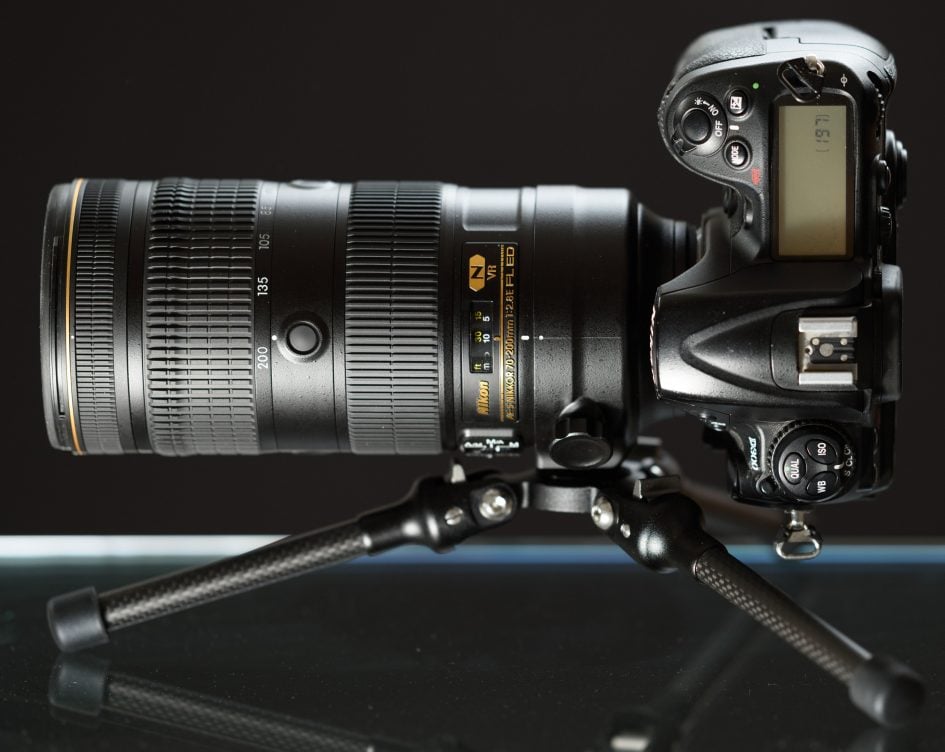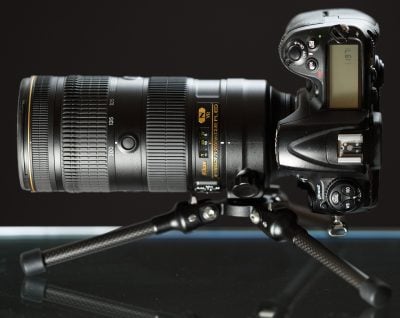Nikon 70-200mm f2.8E VR review
-
-
Written by Thomas
Verdict
The Nikon AF-S 70-200/2.8E FL ED VR is a worthy successor to Nikon’s professional 70-200/2.8G VRii workhorse. Optically it outperforms its predecessor, not to mention the rival 70-200mm f2.8 zooms from Sigma and Tamron at every focal length. It also addresses the concerns of many users of its predecessor that were disappointed by the shrinking effective focal length at close focus: not only can you now auto-focus down to 1.1m (vs. 1.4m) but you can also reach a magnification of 1:4.1 – almost double the 1:7.9 of the predecessor. Even at a distance of 2m the new zoom has a 22% higher magnification than the old one.
Other aspects of the lens are also improved: The AF is much faster, image stabilization is better when filming, focus-breathing is reduced, front and rear lenses are fluorine coated for easier cleaning, and you get configurable buttons on the lens plus a reversed order of focus- and zoom-ring for more stable hand-holding.
What are the downsides? There is mainly one: The new Nikon AF-S 70-200/2.8E FL ED VR is the most expensive in its category even surpassing Sony’s new FE 70-200mm 2.8 GM OSS (which is not available with Nikon mount) by a small margin. And there was some focus-shift on my copy at 200mm focal length that need some judicious AF fine-tuning to work around.
Let’s see how the new lens compares to some alternatives.

Compared to Nikon AF-S 70-200mm f/2.8G ED VRii
The new lens surpasses the image quality of its predecessor at every focal length across the full-frame sensor except for the center performance at 200mm where the older 70-200/2.8G VRii was reputably very sharp. But especially in the medium focal lengths the old lens is no match for the new design. Same with regard to flare, glare, and ghosting: The new lens may not be optimal in this respect but it is clearly better than its predecessor. Its also somewhat lighter than the old lens and the switch in the position of the focus- and zoom-ring is something that I prefer on the new lens: It makes it easier to handle. Plus you get 4 configurable buttons on the new lens which in most cases will be used to lock or initiate AF. And the image stabilization does work better when capturing video. The only thing where the old zoom is visibly better than the new one is vignetting at 200mm and f2.8. But stop down to f4.0 or further and the advantage of the old lens turns into a disadvantage as it never really gets rid of vignetting while the new lens is practically free of vignetting at f5.6. But I wouldn’t overestimate this issue: vignetting can easily be corrected in camera or in post-processing and does not reach values that would worry me – neither with the old nor the new lens. The Nikon AF-S 70-200mm f/2.8G ED VRii is currently over 30% cheaper than its successor – but that may be a moot point when supply runs out.
See my Nikon AF-S 70-200mm f2.8G VRii review for more details.
Compared to Sigma AF 70-200mm f2.8 EX DG APO HSM OS
This design from 2010 shows its age and is no match for the new Nikon: it needs stopping down to f5.6 or f8 to lift border-/corner-performance at longer focal lengths, the AF is not always spot-on, and it has no weather sealing.. But it’s the cheapest way to get a stabilized 70-200/2.8 zoom with a price currently less than a third of Nikon’s 70-200/2.8E VR. It will be interesting to see if and how Sigma updates their design with the kind of performance we’ve come to expect from their hugely successful “Art” series.
See my Sigma 70-200/2.8 OS review for more details.
Compared to Tamron SP AF 70-200mm f2.8 Di VC USD (A009)
This lens from 2012 (model A009) left me with mixed feelings: It seemed like a good design regarding optics as well as AF and image stabilization. But the two copies I tested had nagging issues of decentering, haloing at 200mm f2.8 and the image stabilization needed time to “wake up” and deteriorated in cool weather – although it worked well once awoken. This prevented a recommendation at the time of testing. You may find that newer copies of this lens are in better shape though – but better try before you buy.
See my Tamron 70-200/2.8 VC (A009) review for more details.
Nikon AF-S 70-200mm f/2.8E FL ED VR final verdict
This is simply the best 70-200/2.8 zoom you can buy for your Nikon camera. It combines the best image quality in its class with a very good image stabilization, an acceptable size and weight, and a professional build. Thus Nikon’s new 2.9x telephoto zoom deservedly earns a Highly Recommended rating.
Summary
Good points:
- Very good quality over 36Mp full-frame, even wide open.
- Very good image stabilization.
- Constant f/2.8 focal ratio.
- Works well with 1.4x teleconverter.
- Weather sealing.
- Quiet, very fast, and precise AF operation.
- Maximum magnification of 1:4.1 in MF.
Bad points:
- Expensive.
- Some focus-shift at 200mm.
- Flare and glare not well controlled.
Check prices on the Nikon 70-200mm f2.8E at Amazon, B&H, Adorama, or Wex. Alternatively get yourself a copy of my In Camera book or treat me to a coffee! Thanks!




